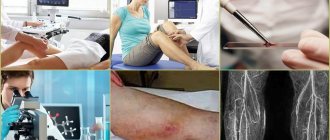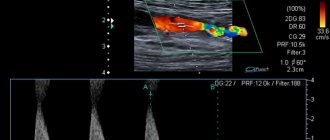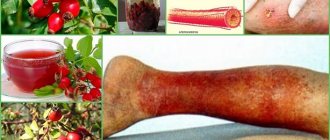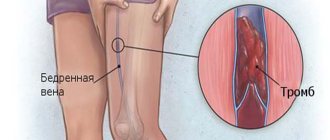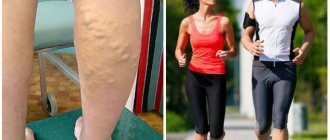Peculiarities
With thrombophlebitis, two key phenomena are observed. This is inflammation of the vessel wall and the formation of a dense thrombotic clot. This phenomenon is provoked by venous stagnation in combination with increased coagulability.
What provokes an increase in hemocoagulation:
- blood diseases that are accompanied by increased platelet production,
- elderly age,
- use of high doses of estrogens,
- excessive blood viscosity,
- the presence of inflammatory processes,
- pregnancy and postpartum period.
- Venous stagnation occurs for the following reasons:
- overweight,
- elderly age,
- lower limb injuries,
- phlebeurysm,
- applying a plaster cast,
- bed rest for 4 days or more.
When all of the above factors are combined, platelets accumulate on the vessel wall. They are enveloped in fibrin in a dense network. For this reason, a blood clot forms. This dense lump can break off at any moment and get into the internal organs. Including, it can move to the pulmonary artery and heart. In the first case, pulmonary embolism will develop, which is considered a dangerous condition.
In what situations is surgery necessary?
There are a number of emergency situations in which surgery will be simply necessary, otherwise a person can say goodbye to his life. There are several types that require emergency surgery, they are as follows:
- Pulmonary artery thrombus or thrombophlebitis of the saphenous vein trunk, and in such cases a rather dangerous situation can arise when parts of the thrombus can begin to migrate through the veins. If this process is not stopped during surgical intervention, a person may die suddenly.
- The most dangerous type is the spread of the disease. In this case, surgical intervention will be aimed only at eliminating the blood clot and saving the person’s life, but it does not guarantee a complete cure for the disease.
- Surgery is also needed when the veins under the skin are affected. In this case, crossectomy with thrombectomy is performed.
- When does damage to the proximal veins occur? In this case, a crossectomy of the superficial veins is performed.
For all such diagnoses of thrombophlebitis, surgical intervention is simply necessary, and if you combine the right surgical method and qualified specialist techniques, you can sometimes save a person’s life and save him forever from a painful disease.
Probability of development
Factors for the development of thrombophlebitis are greatest in postoperative patients. This is facilitated to the maximum extent by immobilizing the patient.
There are criteria according to which thrombophlebitis is divided into 3 degrees:
- Low. The probability of phlebitis formation is 10%. This phenomenon occurs if the surgical procedure lasted no more than half an hour. At the same time, no adverse events were noted, as well as negative factors other than age. Also included in this category are operations in patients under 40 years of age that exceed 30 minutes but do not have other risk conditions.
- Average. Varies from 10 to 40%. In this case, an operation is performed on internal organs that require lengthy manipulation. The patient's age exceeds 40 years. This category includes interventions in people who have had thrombophlebitis before and lasting less than 30 minutes.
- High. It ranges from 40 to 80%. These are orthopedic operations, interventions for limb fractures accompanied by amputation, situations where paralysis of the legs occurs.
Damage to veins can be considered one of the factors of thrombosis. If a catheter is installed, then it is necessary to take preventive measures to protect patients from a dangerous illness.
The type of operation performed significantly influences the factors for the development of thrombophlebitis. For example, during interventions where manipulations are performed on the abdominal organs, patients move with difficulty. And yet they can maintain some physical activity, and therefore the likelihood of developing a blood clot is no more than 30%.
People after knee and hip replacements often cannot get up and walk, which is why the same indicator is at 70%. Their venous blood flow is slow, and therefore dense clots are more likely to accumulate.
Reasons for the development of thrombosis after surgery
After surgery, the patient may develop postoperative thrombosis, which has 3 degrees of risk. Low appears during surgery within 30 minutes in the absence of unfavorable factors. Medium - during a long operation with the presence of predisposition factors. A high degree occurs during orthopedic operations or treatment of injuries, oncological diseases through surgery. The manifestation of symptoms begins with pain in the leg, swelling and discoloration. In the future, fever, chills, nausea, etc. may occur.
Symptoms
Clinical symptoms directly depend on which veins the pathological process occurs in. Most often, thrombosis of the veins of the lower extremities occurs. 80% of cases occur in the right leg area. If the disease affects veins located in the superficial layers, the symptoms are not very pronounced. If there is blockage of the deep veins, acute symptoms occur. They are also expressed in external changes.
Swelling may be noticeable in the affected area. There is pain when touched. These phenomena are gradually increasing. The skin becomes reddish above the site of blockage of the vessel, and below this area, cyanosis can be noted. The affected vessel has the appearance of a dense cord of a purple hue. If you do not provide help to a person in a timely manner, symptoms of intoxication will appear. These are weakness, tachycardia and other general symptoms. This situation can lead to tissue damage and the development of thromboembolism with blood clot separation.
Symptoms of a blood clot in a limb
If blood is redistributed through the system of connecting superficial veins, then the disease may not manifest itself for a long period of time. Subsequently, the subcutaneous network becomes noticeable, which is an indirect sign of obstructed blood flow.
In half of patients, venous thrombosis occurs with the following symptoms:
- feeling of fullness in the limb;
- when pressing along the thrombosed vein, a sharp pain is felt;
- swelling, redness or bluishness of the skin;
- dilated and congested veins under the skin.
Upon palpation, a round or oblong compaction may be detected. Long-term thrombosis leads to venous insufficiency in the form of constant swelling, the formation of ulcerative skin defects, and eczema.
If a blood clot breaks away from the wall, its movement through the pulmonary artery system causes thromboembolism with cardiopulmonary failure and death.
Medicines
Their use is aimed at normalizing blood flow and successfully resolving a dense lump of platelets. The main groups of drugs for conservative treatment of tissue damage to the lower leg and other areas are:
For blood clot resorption: Urokinase and Streptokinase.
To thin the blood: Aspirin, Curantil, Heparin.
Anti-inflammatory tablets: Ketofen, Ibuprofen. You can take antibiotics as needed.
Antispasmodics: No-shpa, Spazmalgon. These drugs reduce the severity of pain.
For intravenous drip infusion: glucose, isotonic sodium chloride solution, ascorbic acid.
During this treatment, it is imperative to wear compression garments and bed rest. If drug treatment does not provide results, or the process occurs in the deep layers of tissue, surgical treatment is prescribed.
Operation
There are several options for surgery for thrombophlebitis of the lower extremities:
Thrombectomy. An instrumental method for removing a blood clot from an affected vessel.
Radio wave surgery. Using radio waves, the blood clot is destroyed. In this case, a special catheter is inserted, at the end of which there is a device for emitting these same waves.
Endovascular surgery. A special probe and catheter are inserted, with the help of which the blood clot is removed.
When choosing one or another surgical intervention option, they are guided by the person’s condition and the severity of the pathology. Usually the decision rests with the doctor, but the patient’s opinion is also listened to. He has the right to refuse certain options for intervention.
Other methods
If drug therapy is ineffective, a vena cava filter is sometimes installed. It is implanted into the inferior vena cava so that the detached thrombus does not emigrate through the vessels and enter the pulmonary artery. A vena cava filter is a structure that opens up like an umbrella and acts as a trap for dense lumps.
Installation of such a filter is carried out at 3 weeks or on an ongoing basis. It is performed under local anesthesia and does not require long hospitalization. We must remember that a fairly large clot can get into the filter, which can block the blood flow. In this case, you will have to urgently remove it. This feature is the only disadvantage of the filter.
Drug therapy
Treatment of thrombophlebitis of the lower extremities with the help of medications is one of the important points in achieving a positive effect. Several groups of specific medications are used, which are used in injection, tablet and ointment forms.
Drug therapy includes the prescription of such drugs as:
- non-steroidal anti-inflammatory drugs;
- anticoagulants;
- disaggregants;
- rutin derivatives;
- enzymes;
- herbal venotonics.
The greatest effect in this pathology is provided by NSAIDs based on Diclofenac (Voltaren, Ortofen) and Ketoprofen (Ketorol, Fastum). A quick result appears after intramuscular injection or the use of rectal suppositories with NSAIDs. They are also prescribed in tablets and ointments. They quickly relieve inflammation and have analgesic properties.
The prescription of systemic direct and indirect anticoagulants for this disease is very rarely required. Only in case of persistent recurrent course, low molecular weight heparins (Fraxiparin, Clexane) are first used, followed by a transition to indirect anticoagulants (Warfarin). In other cases, the use of local gel forms is sufficient. Lyoton, Trombophobe, Trombless are used with success. At the same time, alternating them with NSAIDs is very effective.
As blood thinners (disaggregants), intravenous administration of Reopoliglucin is used at the beginning of treatment. Then Curantil tablets or small doses of Aspirin are prescribed.
Rutin derivatives are obtained from the extract of fragrant rue. Drugs based on it, Troxerutin and Venoruton, have a powerful protective effect on the venous wall. At the same time, they have an anti-inflammatory effect. Topical use is also possible, but the development of allergic reactions to the herbal component limits this.
Systemic use of multienzyme drugs, such as Wobenzym and Phlogenzyme, has an anti-inflammatory, immunomodulatory, decongestant and resolving effect. These tablets should be taken with plenty of water. They help to quickly relieve the symptoms of inflammation without causing allergic reactions.
Phlebotonics are herbal preparations that help relieve inflammation and strengthen the vascular wall. Medicines such as Detralex, Ginkor-fort, Phlebodia are prescribed. They are quite effective means and can be prescribed for the prevention of thrombosis in varicose veins and the post-thrombotic state.
Diet
Nutrition involves eating fresh vegetables and fruits, herbs, and cereals.
What exactly to use and how:
- Cauliflower, white cabbage, broccoli. It is acceptable to eat baked, stewed or boiled. They are added to soups, salads, and used as a side dish.
- Tomatoes are very useful for thrombophlebitis. It is advisable to consume them fresh.
- Lettuce is eaten fresh or combined with herbs and vegetables. It is better to season this salad with lemon juice or vegetable oil.
- Rosehip decoction. Assigned by courses. These plants are rich in vitamin C. The fruits are brewed and cooled to room temperature. Take the resulting drink one glass a day. You can add a little light honey to it.
- Nettle leaves are a good remedy. To prepare a healing remedy, take a few tablespoons of this raw material, add water and bring to a boil. Cool, filter, take 3 glasses a day.
When choosing a diet for thrombophlebitis, it is better to give preference to fruits that are rich in rutin and flavonoids. Particular attention should be paid to nuts. It is enough to consume them 5 pieces per day. They normalize capillary permeability and strengthen their wall.
Among the porridges, the healthiest one is buckwheat. It contains rutin, which improves the elasticity of capillaries. Berries will bring a lot of benefits. They can be varied. You can eat red and chokeberry, currants. It is also advisable to eat at least 100 g of fresh lemons every day, for example, adding them to tea.
Foods such as garlic, ginger, figs, mulberries, and olive oil help thin the blood. It is necessary to enrich your diet with products containing lecithin. These are pomegranates, beets, sunflower seeds.
You should refrain from carbonated drinks, smoked and fatty foods, alcohol, and sugar. Potatoes should be excluded from vegetables for a while. Beans and peas are not recommended. It is advisable to provide a large amount of fluid. If you can’t drink a lot of plain drinking water, you can supplement it with green tea and berry fruit drinks.
Crossectomy
Treatment for deep vein thrombosis of the extremities begins with this particular intervention. It involves the intersection of pathological areas of blood vessels in the area of the saphenofemoral junction. Previously, such a method was called the Troyanov-Trendelenburg operation.
Previously, the area of dissection or puncture was determined by palpation in the area of the inguinal fold, but this method does not always allow one to accurately identify the anastomosis. And all because, due to pathological changes, as well as the characteristics of each patient’s body, this structure may deviate slightly from its normal location.
In modern medicine, when performing a crossectomy to eliminate thrombophlebitis, the saphenofemoral anastomosis is determined by ultrasound.
Crossectomy technique
First you need to determine the locations of future punctures or skin incisions. As a rule, access to the venous junction can be obtained in several ways:
- Supra-inguinal fold. In this case, the puncture is made a few centimeters above the inguinal fold.
- Under the groin fold. The location of the cut is determined in exactly the same way as in the previous version, but in the opposite direction.
- Access through the groin. In this case, the incision is made directly along the inguinal fold area.
If the patient has certain anatomical features, the incisions will be localized with displacements in a certain direction.
The question arises: what indicators influence the location of future incisions in the treatment of thrombophlebitis? To decide on the method of punctures during surgery, the doctor takes into account the following nuances:
- Individual characteristics of the patient’s anatomical structure.
- The degree of progression of deep vein thrombophlebitis.
- The presence of cosmetic defects after vein surgery.
- Type of intervention.
- Other features.
After determining the type of operation and taking into account all the patient’s characteristics, they proceed directly to crossectomy of the veins of the lower extremities. First, the doctor makes an incision in the skin and tissues located under it, gaining access to the saphenous vein, it is worth making sure that this is it.
Next, to eliminate thrombophlebitis, you should secure the vessel well with clamps and cross it. Now all that remains is to process the edges of the vein and apply sutures.
How to identify the saphenous vein?
It is very important to correctly identify the saphenous vein, because it is the one that is crossed during crossectomy. If there is a false identification and damage to another vessel, the patient will only be harmed, and the treatment of thrombophlebitis will be carried out incorrectly.
If thrombophlebitis of the extremities is eliminated by crossectomy, the doctor should know that the saphenous vein and the femoral vein are quite similar, but they can be distinguished by external differences. The first has light and dense walls. The latter is marked by stronger pulsation.
Also, when the saphenous vein is stretched, you may notice the appearance of small folds on the upper thigh. This symptom is explained by tension and displacement of small vessels extending from the main line.
Contraindications
The following conditions are absolute contraindications for crossectomy:
- Advanced somatic diseases, which result in a high risk of complications after deep vein intervention.
- The period of gestation and breastfeeding.
- Atherosclerosis of the lower extremities.
Relative contraindications for eliminating thrombophlebitis using this method include:
- If the patient after surgery is unable to return to an active lifestyle due to physical limitations.
- In cases where it is not possible to perform compression during the rehabilitation period.
- There is an infectious lesion in the tissues where the intervention will be performed.
It is not recommended to treat thrombophlebitis of the extremities in the presence of contraindications by crossectomy, as there is a high risk of complications. In addition, the method may not be effective.
Folk remedies
To prevent thrombophlebitis, specialized exercises and medications are required, but if the patient feels well or was discharged from the hospital fairly quickly, he can supplement these methods with folk remedies. They will be useful at any stage, including for absolutely healthy people. Such measures are aimed at strengthening the venous wall and eliminating inflammation in the initial stages.
Compresses
A compress using sea salt is very useful. Take a teaspoon of salt and dilute it in a liter of cool water. Soak a towel in a salty solution and apply it to your feet. These dressings need to be changed every half hour.
Vodka compress is one of the most accessible methods. It is enough to moisten a piece of cloth in medical alcohol or vodka, apply it to the sore area, and secure it with a bandage.
If all of the above is not available, you can use raw potatoes. You need to grate several tubers and apply them to the sore limb. This compress should be secured with a gauze bandage or towel. It must be kept for at least 5 hours.
Fresh leaves of cabbage, lilac, and horseradish have a good effect. First of all, they cool the sick part of the body well. Experts advise beating them a little before using to release the juice. You can coat it with a thin layer of sunflower or olive oil and then secure it with a bandage. The compress should be kept for 3 hours, after which it should be replaced with a new one.
Alcohol tincture of white acacia is another common recipe. They prepare it with their own hands. To do this, pour 300 ml of medical alcohol into three tablespoons of flowers. Place in a dry and dark room and leave for 3 weeks. Apply to the affected area of skin for 3 hours. It is recommended to use this solution after diluting it with water by 40%.
Dimexide is a drug with a pronounced analgesic, anti-inflammatory and antibacterial effect. The liquid product normalizes metabolism in tissues. To make a medicinal compress, dilute it in equal proportions with cool water. Moisten a gauze cloth, apply it to the leg and leave for 3 hours. Place a warm scarf or plastic wrap on top.
Herbs
Most often, Kalanchoe is used to prevent thrombophlebitis. Grind two tablespoons of the leaves of a young plant, pour in 200 ml of vodka and leave in a cool place for a week. Wipe the damaged areas of the skin with the prepared tincture.
Verbena officinalis is well suited for thinning the blood. 15 g of leaves are poured with a cup of boiling water and left for half an hour. Take a tablespoon every hour.
Take a tablespoon each of string, chamomile, sage and bird's eye knotweed. Mix, take five spoons of the resulting mixture and pour in 1 liter of warm water. Place on low heat and boil for 5 minutes. Wrap in a towel and leave for 2 hours. Use a ready-made product for rubbing and compresses.
Pour one and a half tablespoons of melilot with hot water, leave for an hour, and filter. Take two tablespoons 30 minutes before meals, 3 times a day.
Horse chestnut is widely used. You can make an alcohol tincture and take 20 drops of this product three times a day before meals. It can be bought ready-made at any pharmacy. It is also good to use it as part of foot baths. Take crushed flowers or kernels in the amount of 2 tablespoons, add a liter of hot water and boil over low heat for 10 minutes. The finished decoction is used for healing baths.
There is another recipe. Take several small chestnuts, chop them, pour in 100 ml of vodka and leave in a dark place. The finished product is consumed 3 times a day, 30 drops, half an hour before meals.
An ointment based on horse chestnut is effective. Take 10 crushed chestnuts and mix with the same amount of butter, rub your feet with the resulting ointment.
Clinical manifestations, diagnosis
Postoperative thrombophlebitis can be suspected if pain and swelling of one of the legs suddenly appears. In addition, the following manifestations of pathology are possible:
- pain increases when standing up or walking;
- there is fatigue in the legs;
- burning sensation, swelling in the limbs;
- swelling of the saphenous veins;
- a sharp rise in temperature and chills are possible.
To confirm the diagnosis, the following research methods are usually performed:
- Duplex ultrasound . A non-invasive method that allows you to evaluate the forward flow in the veins of the lower extremities and determine where the blood clots are located.
- Contrast venography . Today, this method of diagnosing pathology of the leg veins, which involves the introduction of contrast agents into the venous bed, is rarely used.
- Computed tomography or magnetic resonance venography . Quite informative methods, but due to their high cost, they are rarely used in clinical practice.
In case of pulmonary artery thrombosis, the following symptoms are possible:
- sudden shortness of breath;
- sharp pain in the chest, which intensifies with a deep breath or cough;
- tachycardia (accelerated heartbeat);
- rapid breathing;
- sweating;
- anxiety;
- hemoptysis;
- loss of consciousness;
- signs of a collapsed state.
To confirm pulmonary artery thrombosis, your doctor may prescribe:
- chest x-ray;
- electrocardiography (ECG);
- D-dimer assay;
- CT (computed tomography);
- magnetic resonance imaging (MRI);
- Dopplerography;
- echocardiography.
Prevention
Thrombosis of complex forms after surgery is rare. Still, it is advisable to carry out prevention, which consists of several components. The possibility of thromboembolic complications, intestinal thrombosis, hemorrhagic complications with the appearance of a hemorrhoid should always be taken into account after operations. A floating thrombus may form, which poses the greatest danger.
Firstly, it is necessary to achieve early activation of the patient. This means that the sooner he starts walking, the better. He should at least move around the ward. If he has undergone endoprosthetics or metal synthesis, he can be raised the next morning. Activity should be gradually increased. Various load options are possible here. Age does not matter. Even the presence of concomitant pathology is not a contraindication. Activation should also occur in bed. The operated limb should be elevated regularly.
The first day the patient usually lies in bed. Now we need to recommend simple exercises that he can do. This is raising the knee, flexing and extending the feet. So-called isometric exercises are also necessary. They involve muscle tension. As soon as the patient begins to walk, he needs to do exercises in a standing position. Exercises in bed are also continued. Favorable conditions for blood flow in the veins are created by the work of ligaments and muscles, as well as joints.
Compression knitwear has a compressive effect. These are good tools for preventing blood clots. Stockings should be put on immediately after the operation. Sometimes they are pulled onto a healthy limb before the intervention. The patient must wear them at all times. Shooting is allowed only when it assumes a horizontal position.
Elastic bandages have been widely used in the past, but they have many disadvantages. They stretch and move from the place of fixation. Thus, the entire effect they have comes to naught. In addition, in order to apply which bandage, you need to have skill and experience. There should be more pressure at the bottom than at the top. If a person does not have special training, he cannot cope with this manipulation.
Compression hosiery is manufactured with compression selected for different categories of patients. The greatest compression is observed at the level of the ankles. It is minimal in the area of the upper third of the thigh. Choosing the right size is very important. To do this, you should measure the volume of the lower limb at different levels. Such underwear also differs in the degree of compression. For the purpose of prevention, you can select the first or second degree. Some companies involved in the production of stockings write on them the designation “hospital anti-embolic”.
There are many medications suitable for prevention. Low molecular weight heparins were considered a kind of gold standard. These are drugs such as Fraxiparine, Clexane, Fragmin. But now they have been replaced by tablet forms of medications with greater effectiveness: Prodaxa, Xarelto, Eliquis. They block the factors responsible for activating the formation of blood clots. Taking these tablets continues from 2 to 5 weeks after surgery.
All of these measures taken together are the prevention of thrombosis. This should include negative aspects that you can reduce yourself. This is getting rid of varicose veins, normalizing weight, adjusting the diet with a predominance of vegetables and herbs.
Predisposing factors
The process of blood clot formation refers to the protective functions of the body. During surgery, the integrity of tissues and all kinds of blood vessels (capillaries, veins) is damaged. The body's defense mechanisms turn on and small blood clots appear that close the damage.
An important factor in the formation of blood clots is prolonged immobility of the patient. In this case, normal blood circulation is disrupted and venous blood flow slows down. Most often, this situation occurs during operations on the lower extremities followed by the application of a plaster cast.
In addition, a number of factors are necessary, the presence of which increases the risk of developing blood clots:
- High blood clotting.
- Age exceeding 40 years of age.
- Prolonged immobility of the patient caused by paralysis, compound fracture or other reason.
- Obesity.
- Diabetes.
- Varicose veins.
- Malignant neoplasms.
- Pathological processes of the cardiovascular system. Heart attacks, ischemia, cardiovascular, venous insufficiency and others.
- Inflammatory bowel diseases.
- Long-term use of estrogen.
- Large surgical operations, long surgical time.
- Fractures of the pelvic bones and lower extremities.
Postoperative thrombosis of the lower extremities
Postoperative thrombosis of the lower extremities occurs due to blockage of the lumen of the vessel by a thrombus or embolus, broken off as a result of the operation or introduced during the operation by an air bubble or fatty layer.
Causes of thrombosis of the lower extremities
The veins of the lower extremities are most often affected due to postoperative complications. With blood circulation in the legs, the dynamics of blood flow in the legs are especially important. If the muscles of the lower leg suffer due to postoperative immobility or paralysis, then the intensity of blood flow in them drops sharply.
And if this is combined with factors such as damage to the vascular wall or a disorder in the coagulation system, then there are all the prerequisites for the occurrence of thrombosis.
Postoperative thrombosis of the lower extremities also develops due to the fact that during surgery the platelet system of the body is activated, designed to stop postoperative bleeding and promote the healing of damaged tissues.
Given the reduced dynamics of blood flow in the lower extremities of a lying person, there is a threat of platelet accumulation in a dense lump of formed elements, blocking the lumen of the vessel.
This disease most often affects people who already have a pathology that predisposes them to its development:
• cardiovascular diseases, • diabetes mellitus, • increased obesity, • previous paralysis and paresis, • oncology,
• immobility as a result of injury.
Course of the disease
Among postoperative thromboses of the lower extremities, phlebothrombosis and thrombophlebitis are distinguished. In the first case, a blood clot occurs in an undamaged vessel. It is brought by the bloodstream or occurs due to platelet aggregation.
Most often, the vessel is not completely blocked, the blood is able to move in the right direction. Such thrombosis cannot always be noticed and prevented in time, since clinical manifestations are either absent or very mild.
In the second case, a thrombus appears in the thickness of the vascular parenchyma, damaged as a result of surgery or during a pre-existing inflammatory or traumatic process.
In this case, secondary inflammation occurs due to impaired blood supply to the blocked area and the release of tissue breakdown products. In this situation, the blood supply is completely disrupted; the blood clot completely blocks the lumen of the vessel.
Features of localization of blood clots in the lower extremities
As already mentioned, most often the localization of such blood clots is the lower leg area; therefore, the first symptom indicating the development of postoperative thrombosis of the lower extremities is pain in the calf region. Gradually, limited mobility of the leg joins it.
The limb swells, turns red, gradually acquiring a bluish tint, and an increase in temperature is observed. The patient feels as if the leg is swelling. When pressing on soft tissues, the patient feels a sharp pain.
If all three paired veins of the leg are blocked by a blood clot, the condition can become dangerous, even leading to the loss of a limb.
If thrombosis affects the vessels of the thigh, then the main symptom is swelling.
This type of thrombosis is not so dangerous, since there are collaterals in the thigh, so the blood supply to the tissues does not completely stop. Otherwise, the symptoms are similar to thrombosis of the vessels of the leg. When pressing on soft tissues, the patient also feels pain. The limb moves with difficulty.
Gradually, the leg acquires a bluish tint and its temperature begins to drop. If measures are not taken in time, the tissues of the leg become denser, secondary compression of the vessels occurs and a strong inflammatory process begins. The pain becomes throbbing.
Treatment
Conservative treatment of postoperative thrombophlebitis:
- The patient is prescribed bed rest in the acute phase of the disease. The affected lower limb is fixed in an elevated position on a special splint. The limbs are elastically bandaged and compresses are applied with anti-inflammatory and absorbable ointments.
Bed rest - Non-steroidal anti-inflammatory drugs are prescribed to relieve inflammation and pain.
- Anticoagulants and thrombolytics are prescribed. Heparin and fibrinolysin are often prescribed.
- To relieve pain and spasm of vascular smooth muscles, antispasmodics (no-spa, papaverine), vasodilators (aminophylline, nicotinic acid, their derivatives) are used.
- Antihistamines and diuretics are used to reduce swelling.
- In the subacute stage of the disease, drugs are used aimed at improving the condition of the walls of blood vessels - aescusan, glivenol.
- When the inflammatory process is severe and other means are ineffective, glucocorticoid drugs are used.
- When a secondary infection occurs or purulent complications develop, broad-spectrum antibiotics are administered.
- In the acute period, infusions of drugs that improve rheological blood parameters are prescribed.
- In the subacute period, the recovery phase, vitamins, physiotherapeutic treatment, and mud procedures are used.
Treatment of complications such as pulmonary embolism and thrombosis of mesenteric vessels is carried out in intensive care and intensive care settings.
When the main vessels are blocked, surgical treatment is performed. The goal is to restore the patency of the lumen of blood vessels.
After surgery, elastic bandaging of the affected limb is necessary.

